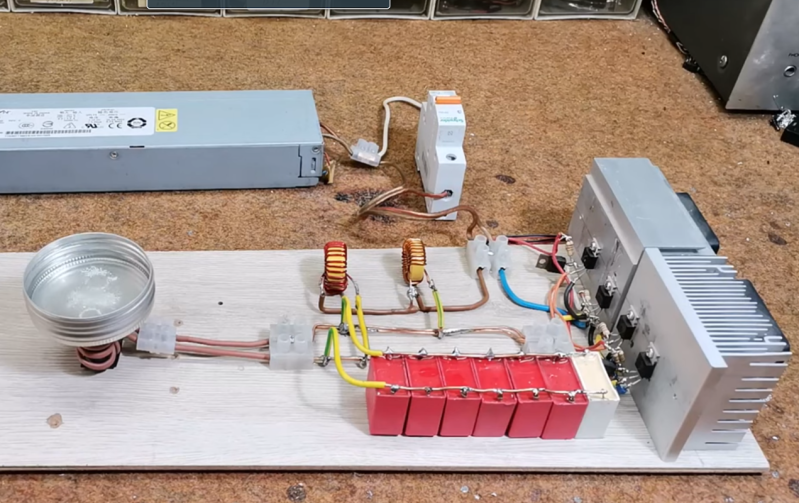Induction cook tops are among the most efficient ways of cooking in the home that are commercially available to the average person. Since the cook surface uses magnetic fields to generate heat in the cookware itself, there is essentially no heat wasted. There are some other perks too, such as faster cooking times and more fine control, not to mention that it’s possible to build your own induction stove. All you need is some iron, wire, and a power source, and you can have something like this homemade induction cooker.
This induction heater has a trick up its sleeve, too. Instead of using an air coil to generate heat in the cookware, this one uses an iron core instead. The project’s creator [mircemk] built an air core induction stove in the past, and this new one is nearly identical with the exception of the addition of the iron core. This allows for the use of less wire, and uses a driver circuit called a Mazzilli ZVS driver running through some power MOSFETs to power the device. A couple inductors limit the current to 20A, but it appears to work just as well as the previous stove.
This build puts a homemade induction stove well within reach of anyone with an appropriate power supply and enough wire and inductors to build the coils. [mircemk] has made somewhat of a name for himself involving project that use various coils of wire, too, like this project we featured recently which uses two overlapping air-core coils to build an effective metal detector.
















“Since the cook surface uses magnetic fields to generate heat in the cookware itself, there is essentially no heat wasted. ”
Title Photo: Device with large heat sinks….
I had to smile there too looking at those large heat sinks to the right…. Might want to have a bun warmer over there and use some of that heat :) .
I’m waiting for the first combo induction cooktop and wireless charger, it will be the “microwave charging trick” hilarity all over again if ppl forget which way to set the switch.
There’s some high-power (300W+) inductive charging systems on the market already that use an RFID tag on the end device before starting high-power charging. For a cooktop, you could send a few low-power pulses to identify if there’s a pan over the coil versus something smaller or something electronic, and adjust accordingly. Good application for NFC.
I’m picturing a cooktop that doubles as a laptop charger.
Induction heater with “Frrite” Core Coil … Maybe spend 10 seconds to proof read video title before submitting :D
It’s an alloy of ferrite and covfefe.
Nah, “Frrite” is just really, really cold iron.
Spotter le québecois!
https://gizmodo.com/study-people-who-point-out-typos-are-jerks-1767969516
You can get the innards of an induction stove quite cheaply from the usual china suppliers. Unfortunately, as with all this stuff the UI has been conflated with the actual function. So the only way to ‘hack’ these devices is to emulate the button and display board.
I really wish there was a cheap commoditised induction controller providing only the induction mechanism, with say an spi interface to control the output power. You could then come up with custom ‘policy’ control and UI.
Perhaps something like that exists, eg the xiaomi mijia cooker seems to be structured this way.
Here is an IC that seems able to do this job: https://www.dialog-semiconductor.com/sites/default/files/2022-03/iW248_Datasheet.pdf
Nice, thanks!
Not sure I have the chops to design (or even copy the reference design) this into a working cooker.
But now we just need china to churn out cheap boards based on this, rather than the preprogrammed Holtek chips they all seem to use now.
This looks like it is crazy inefficient. Look at a commercial one and you will not see a power supply or big heat sinks. Heat sinks for sure but not like that. I did not ponder the schematic but if this is an open loop device, they tend to self destruct if the load changes too much. The commercial ones sense that and adjust. This is one of those for the love of it kind of deals as I don’t see any improvement over what you can buy pre fab on any front. The only thing I do not like about the pre fab ones is the PWM on the lower heat or power settings is in the seconds on and off and not in the ms on and off. No doubt they will fix that at some point though. And the commercial ones have that thermistor so they can do raw power or temperature control. Oh and mine can do 1800W, if that power supply is the power supply for the heat side and not just the electronics, it will not even be close performance wise.
Hi,
releasing power in packets of seconds instead of ms is due to EMI regulations.
It’s called flicker: https://en.wikipedia.org/wiki/Power-line_flicker.